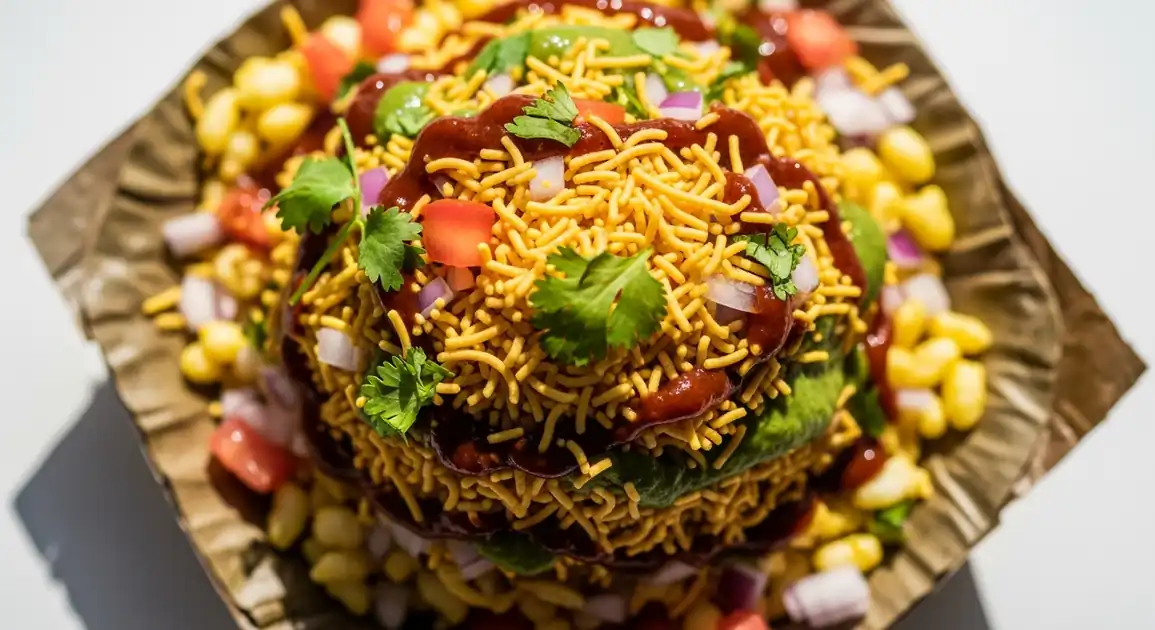Bhel Puri
भेल पूरी

Description
Bhel Puri is beloved nationwide in India but is most authentic in its birthplace of Mumbai. While available in cities across the country, each region adapts the recipe slightly to local tastes – southern versions tend to be spicier, northern versions often sweeter. Recognized as one of India's most popular street foods, bhel puri represents the country's knack for creating complex flavors from simple ingredients.
Dietary Information
Serving information
Serving style
Traditionally served in a dona (leaf bowl), paper cone, or disposable plate. Eaten immediately with a small wooden or plastic spoon provided by the vendor.
Quick facts
Most bhel puri vendors operate from 12 PM to 9 PM, with peak hours between 4 PM and 8 PM.
Safety Tips
What to Look For
-
Fresh, covered ingredients in clean containers
Ingredients should be stored in covered containers to protect from flies, dust, and pollution. Vegetables should look freshly cut and vibrant.
-
Individual mixing for each customer
The vendor should prepare each serving individually upon order, not pre-mix and serve from a ready batch, which can become soggy and collect bacteria.
-
High customer turnover
Popular vendors have frequent customers, ensuring ingredients don't sit out long and are replenished regularly.
-
Clean, organized workstation
The preparation area should be tidy with separate utensils for different ingredients and visible efforts to maintain cleanliness.
-
Freshly made, properly stored chutneys
Chutneys should look freshly made, not oxidized or fermented, and kept in clean, covered containers.
What to avoid
-
Pre-mixed bhel sitting in large batches
Avoid vendors who pre-mix bhel and let it sit, as this allows bacterial growth and results in soggy texture.
-
Uncovered ingredients exposed to flies/dust
Ingredients left open to the environment collect contaminants, especially in busy street/beach settings.
-
Visibly dirty water used for chutneys or washing
Water quality is crucial as chutneys and sometimes ingredients are rinsed with water. Avoid if you notice questionable water sources.
-
Vendors handling money and food without washing
Cross-contamination from currency to food is a common issue. Look for vendors who have separate people handling money or who wash/sanitize between tasks.
-
Old, discolored vegetables or wilted herbs
These indicate poor inventory management and potentially unsafe food practices.
Price information
Price range
Budget tips
- Street vendors typically charge between 20-50 INR for a standard serving.
- Beach vendors at tourist spots often charge 40-60 INR.
- Restaurants and food courts typically charge 60-100 INR for more hygienic preparation.
- Avoid vendors with extremely low prices as they may use inferior ingredients.
Value indicators
- Fresh, vibrant-looking ingredients
- Made to order (not pre-mixed)
- Generous toppings of sev and chutneys
- Balanced flavor profile with distinct sweet, sour and spicy notes
- Clean preparation area with covered ingredients
Where to Find This Dish
Beaches & Waterfronts
Beach and waterfront areas nationwide typically have multiple bhel puri stalls, offering the classic seaside snacking experience.
Beaches, Lakesides, Riverfront promenades
Evening, Weekend afternoons
Street Food Markets
Dedicated street food hubs in most cities have multiple chaat vendors offering bhel puri among other snacks.
Local chaat markets, Food streets
Evening, Night
Tourist Areas
Areas frequented by domestic tourists often have bhel puri vendors catering to visitors wanting to try regional specialties.
Monument surroundings, Tourist shopping areas
Afternoon, Evening
Vendor Tips
- Ask locals for vendor recommendations rather than choosing randomly.
- Vendors wearing gloves or using utensils (not hands) typically maintain better hygiene.
- A little customization (less spicy, more sev) shows the vendor is making it fresh.
How to Order
Regional Variations
-
Sukha (Dry) Bhel
(सूखा भेल)
Contains less chutney, maintaining crispiness longer. Popular for takeaway as it doesn't get soggy quickly.
-
Dahi Bhel Puri
(दही भेल पूरी)
Topped with yogurt for a creamier, milder taste that balances the spices and adds coolness.
-
Chinese Bhel
(चाइनीज भेल)
A Mumbai-Chinese fusion using crispy noodles instead of puffed rice, with schezwan sauce and cabbage.
-
Bhel Puri with Sprouts
(अंकुरित भेल)
Healthier version with sprouted moong beans adding protein and nutrition.
-
Kurmura Bhel
(कुरमुरा भेल)
Simplified version focusing on the puffed rice with minimal additions, often served at homes.
Cultural context
History
Originating from the beach stalls of Mumbai (formerly Bombay) in the 1970s, Bhel Puri evolved from simple beach snacks into a national street food sensation. Its roots trace back to Gujarat's dry 'chidwa' snack mix, combined with Maharashtra's love for complex chutneys. Initially popular at Juhu and Chowpatty beaches where vendors created the perfect mix to enjoy while watching waves, it captured the city's diverse cultural influences and became emblematic of Mumbai's fast-paced street food culture, eventually spreading throughout India.
Local significance
Bhel puri represents India's street food ingenuity and the cultural importance of chaat (savory snacks). It embodies the Indian culinary philosophy of balancing multiple flavors and textures in a single dish.
Eating customs
- Eaten immediately after serving while still crisp.
- Usually eaten standing at the stall rather than as takeaway.
- Customizing spice level and ingredients is common and expected.